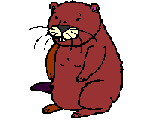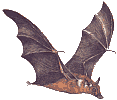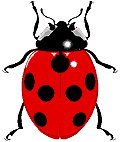Hibernation is different from sleep. While sleeping, an animal moves, has an active brain and can wake up quickly.
There are different kinds of hibernation. A "true" hibernator appears to be dead because the animal's heart rate slows down
and the body temperature drops to almost the same temperature as the outside Breathing slows down.
It takes a long time for the animal to wake up and to move about. Some animals (like bears) are not true hibernators.
In the late summer and fall, before going into hibernation, animals eat a lot of food. Their bodies are able to live off the stored body fat.
They look for a safe place to spend the winter. (caves, dens, burrows)
Some hibernating animals wake up and move around, have a snack and then go back into
hibernation again.
NOTE: "Torpor" is a shortened sleep time. The heart rate slows down and body temperature goes down, but the animal is able to wake up and move around.

GROUND SQUIRRELS (GOPHERS)
In spring, ground squirrels come out of their underground dens in April and May.
The young are born about a month later and come out of
the burrows in early June.
During the summer they eat plenty of food and fatten up. By the end of June, adult males go into hibernation.
Adult females do the same in July. But the young are active all summer.
In September when there is less food to be found they go into hibernation.
They dig a burrow with many tunnels, openings,
and different rooms called chambers. If a predator (enemy)
comes in one hole, they can escape out another hole.
Ground Squirrels store some food.
During hibernation they may wake up and eat.
OTHER ANIMALS THAT HIBERNATE

Some BATS are hibernators. In the fall large flocks of Big Brown Bats find
shelter for the winter. The bats hang upside down and pull their wings
and tails close to their bodies to keep warm. Their body temperature drops
and they seem to be dead. Bats hibernate from October to April,
waking up once a month. Bats likes warm buildings to hibernate in
and are able squeeze through a very small hole.

FROGS hibernate at the bottom of streams and ponds where the
water does not freeze. Woodland frogs find shelter under leaves
and dirt. During the winter they freeze but thaw out and wake up
in the spring.

Hundreds of SNAKES hibernate together so they can stay warm. Snake dens can be found in rocks,
burrows, old wells and basements.

LADYBUGS spend the winter in a state of sleep known as diapause. They fatten up for the winter by eating plenty of aphids and pollen. Then they hide in buildings or under logs, rocks or piles of leaves.
Many other insects also fall into a deep sleep and wait for warmer weather to arrive.

BEARS are not "true" hibernators. They go into their
dens (caves, hollow trees, river banks) in the fall
Their body temperature drops a little and their heart rate slows down, but not as much as true hibernators.
Bears go into a "torpor" or temporary sleep and can wake up and walk around.
The tiny cubs are born in the dens during the winter season.
Bears eat and eat in the late summer and fall,
so that they can store fat before going to their dens. When they come
out in the spring, bears are thin and very hungry. Female polar bears
will spend the winter in dens if they are going to give birth.
There are other animals that are not "true" hibernators. They take "naps" during the winter and wake up often.
ANIMALS THAT SLEEP AND EAT
during the winter
BACK

"Selected by the SciLinks program, a service of National Science
Teachers Association.
Copyright 1999-2002."
|






